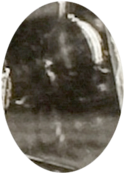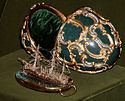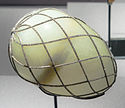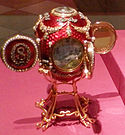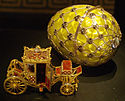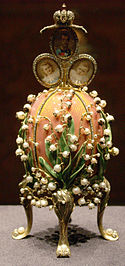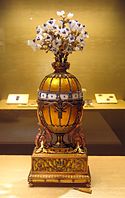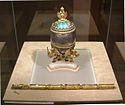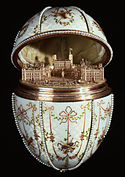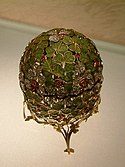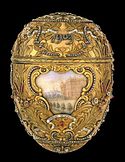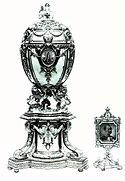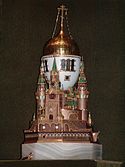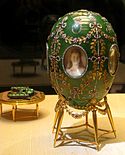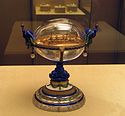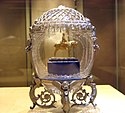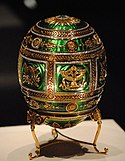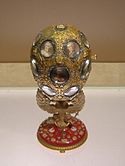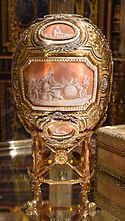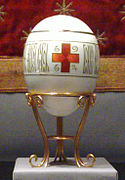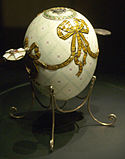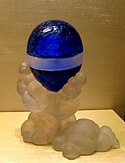فابرجے انڈہ
Appearance

فابرجے انڈہ (Fabergé egg) (روسی: яйца Фаберже́; yaytsa Faberzhe) پیٹر کارل فابرجے (Peter Carl Fabergé) اور اس کی کمپنی کے 1885ء سے 1917ء کے درمیان محدود تعداد میں بنائے جانے والے انڈوں میں سے ایک مرصع انڈہ ہے۔[1]
ان میں سب سے زیادہ مشہور روسی زار الیگزینڈر ثالث اور نکولس ثانی کے لیے بنائے جانے والے انڈے ہیں جو انھوں نے ایسٹر کے موقع پر اپنی بیویوں اور ماؤں کے لیے بطور تحفہ بنوائے۔ فابرجے کمپنی نے تقریبا پچاس انڈے بنائے جن میں سے 43 باقی بچے۔[2]
انڈوں کی فہرست
[ترمیم]حوالہ جات
[ترمیم]- ↑ "Faberge Egg, In Classic Style, History, Easter Egg, James Bond | In Classic Style"۔ 25 جون 2012 میں اصل سے آرکائیو شدہ۔ اخذ شدہ بتاریخ 08 اگست 2015
- ↑ The Fabergé Imperial Easter Eggs,by Fabergé, Skurlov, Proler, London, 1997, page 90. ISBN 0-903432-48-X
- ↑ Also known as the Jeweled Hen Egg, it was the first in a series of 54 jeweled eggs made for the Russian Imperial family under Peter Carl Fabergé's supervision. It was delivered to Tsar Alexander III in 1885. The tsarina and the tsar enjoyed the egg so much that Alexander III ordered a new egg from Fabergé for his wife every Easter thereafter.
- ↑ Also known as the Egg with Hen in Basket, it was made in 1886 for Alexander III, who presented it to his wife, the Empress Maria Feodorovna.
- ↑ A jewelled and ridged yellow gold Egg with Vacheron & Constantin watch stands on its original tripod pedestal, which has chased lion paw feet and is encircled by coloured gold garlands suspended from cabochon blue sapphires topped with rose diamond set bows. In 2014, it was purchased by London-based jeweler Wartski on behalf of an unidentified private collector.
- ↑ Anita Singh (18 March 2014)۔ "The £20m Fabergé egg that was almost sold for scrap"۔ The Telegraph۔ 25 دسمبر 2018 میں اصل سے آرکائیو شدہ۔ اخذ شدہ بتاریخ 19 مارچ 2014
- ↑ Also known as the Angel with Egg in Chariot, crafted and delivered in 1888 to Alexander III. This is one of the lost Imperial eggs, so few details are known about it.
- ↑ Crafted and delivered to Alexander III, who presented it to his wife, Maria Feodorovna, on Easter 1889.
- ↑ Crafted and delivered to Alexander III, who presented it to his wife, Maria Feodorovna, on Easter 1890. || Matilda Geddings Gray Foundation and housed in the Metropolitan Museum of Art in New York City, New York.
- ↑ Matilda Geddings Gray Foundation. Displayed in the Metropolitan Museum of Art in New York City, New York.
- ↑ Before March 2014 mistaken for the third imperial egg
- ↑ Also known as Revolving Miniatures Egg
- ↑ Also known as the Alexander III Portraits Egg.
- ↑ Hillwood Museum have identified the twelve monograms Egg previously dated to 1895 as the Alexander III portraits egg of 1896, http://artdaily.com/index_iphone.asp?int_sec=2&int_new=69441#.U00JNu29LCQ آرکائیو شدہ (Date missing) بذریعہ artdaily.com (Error: unknown archive URL)
- ↑ Surprise is missing.
- ↑ Only the Egg's surprise has survived.
- ↑ Made under the supervision of the Russian jeweler Peter Carl Fabergé in 1898 by Fabergé ateliers. The supervising goldsmith was Michael Perchin. The egg is one of two in Art Nouveau style. It was presented on April 5 to Tsar Nicholas II, and was used as a gift to the tsaritsa, Empress Alexandra Fyodorovna.
- ↑ Also known as the Orange tree egg
- ↑ The egg was made by Henrik Wigström, "Fabergé's last head workmaster". It was given to Maria Fedrovna by her son Nicholas II. Its surprise (now lost) was "a mechanical sedan chair, carried by two blackamoors, with Catherine the Great seated inside".
- ↑ "Hillwood Estate, Museum & Gardens - The Catherine the Great Egg"۔ 04 دسمبر 2013 میں اصل سے آرکائیو شدہ۔ اخذ شدہ بتاریخ 08 اگست 2015
- ↑ Made during پہلی جنگ عظیم, the Order of St. George egg commemorates the Order of St. George that was awarded to Emperor Nicholas and his son, the Grand Duke Alexei Nikolaievich.
- ↑ The Order of St. George egg and its counterpart the Steel Military egg were given a modest design in keeping with the austerity of پہلی جنگ عظیم,
- ↑ ""Mieks Fabergé"۔ August 2013۔ 23 اپریل 2015 میں اصل سے آرکائیو شدہ۔ اخذ شدہ بتاریخ 08 اگست 2015
- ↑ The Order of St. George egg left روسی سوویت وفاقی اشتراکی جمہوریہ with its original recipient, the Dowager Empress Maria Feodorovna.
- ↑ "Faberge"۔ Treasures of Imperial Russia۔ 28 جولائی 2007 میں اصل سے آرکائیو شدہ۔ اخذ شدہ بتاریخ 26 مارچ 2012
- ↑ Created in 1917, the egg was due to be completed and delivered to the tsar that Easter, as a present for his mother, the Empress Maria Feodorovna. But before the egg could be delivered, the February Revolution took place and Nicholas II was forced to abdicate on March 15. On April 25, Fabergé sent the Tsar an invoice for the egg, addressing Nicholas II not as "Tsar of all the Russians" but as "Mr. Romanov, Nikolai Aleksandrovich". Nicholas paid 12,500 rubles and the egg was sent to Grand Duke Michael Alexandrovich at his palace, for presentation to the empress, but the duke fled before it arrived. The egg remained in the palace until it was looted in the wake of the October Revolution later that year
- ↑ Because of the Russian Revolution of 1917, this egg was never finished or presented to Tsar Nicholas's wife, the Tsaritsa Alexandra Feodorovna. Two eggs have claims to be the Constellation egg: one held at Fersman Mineralogical Museum in Moscow and the other in the possession of Alexander Ivanov and displayed at Ivanov's Fabergé Museum in Baden-Baden, Germany.



